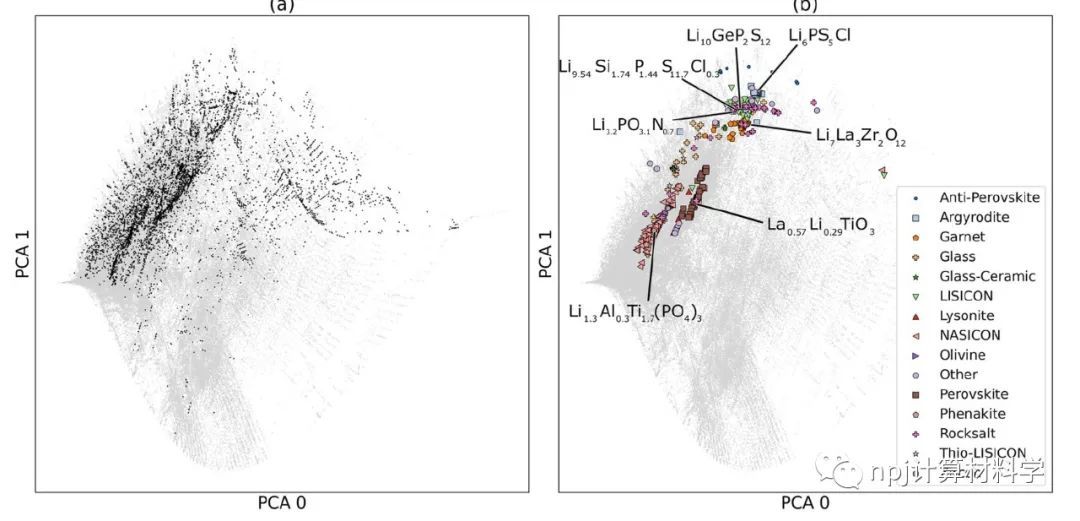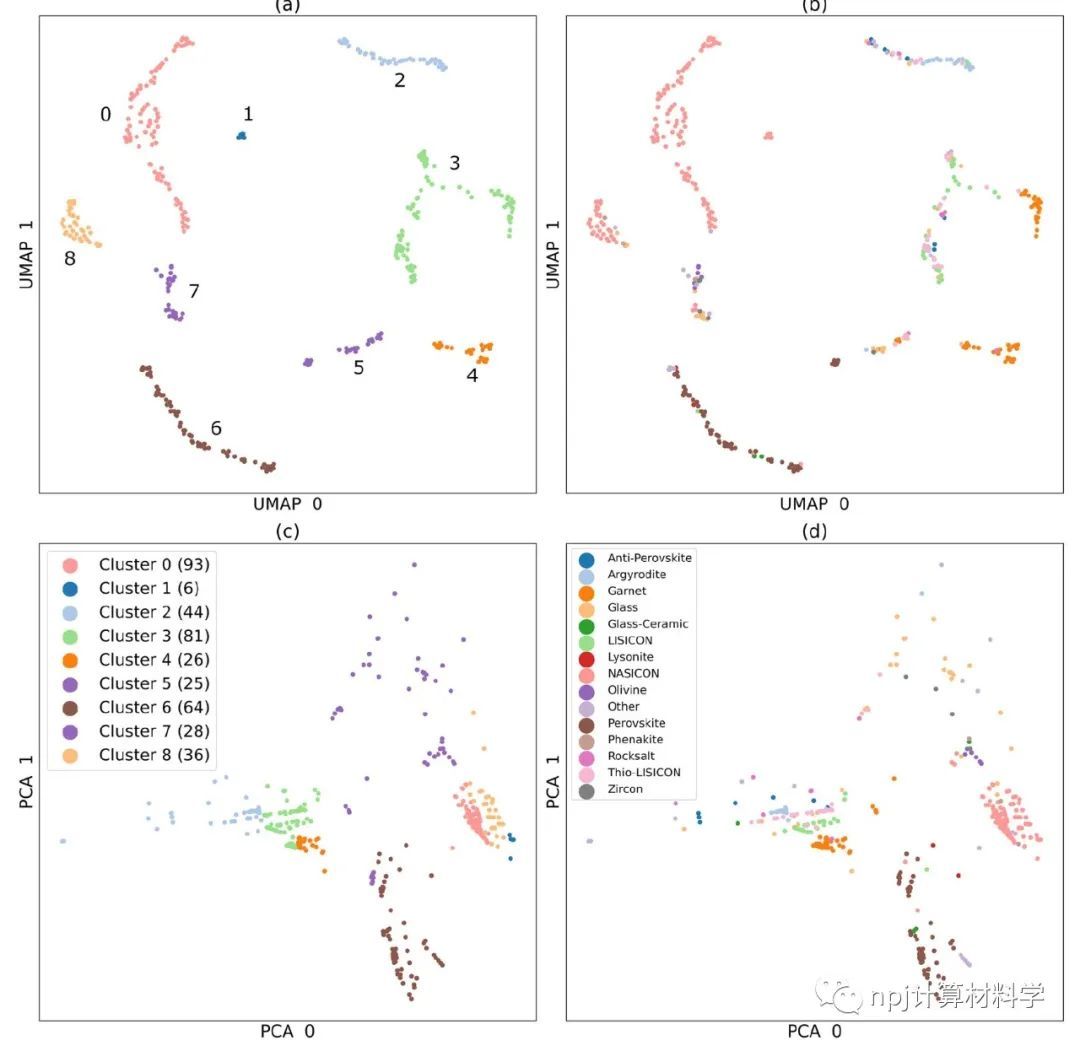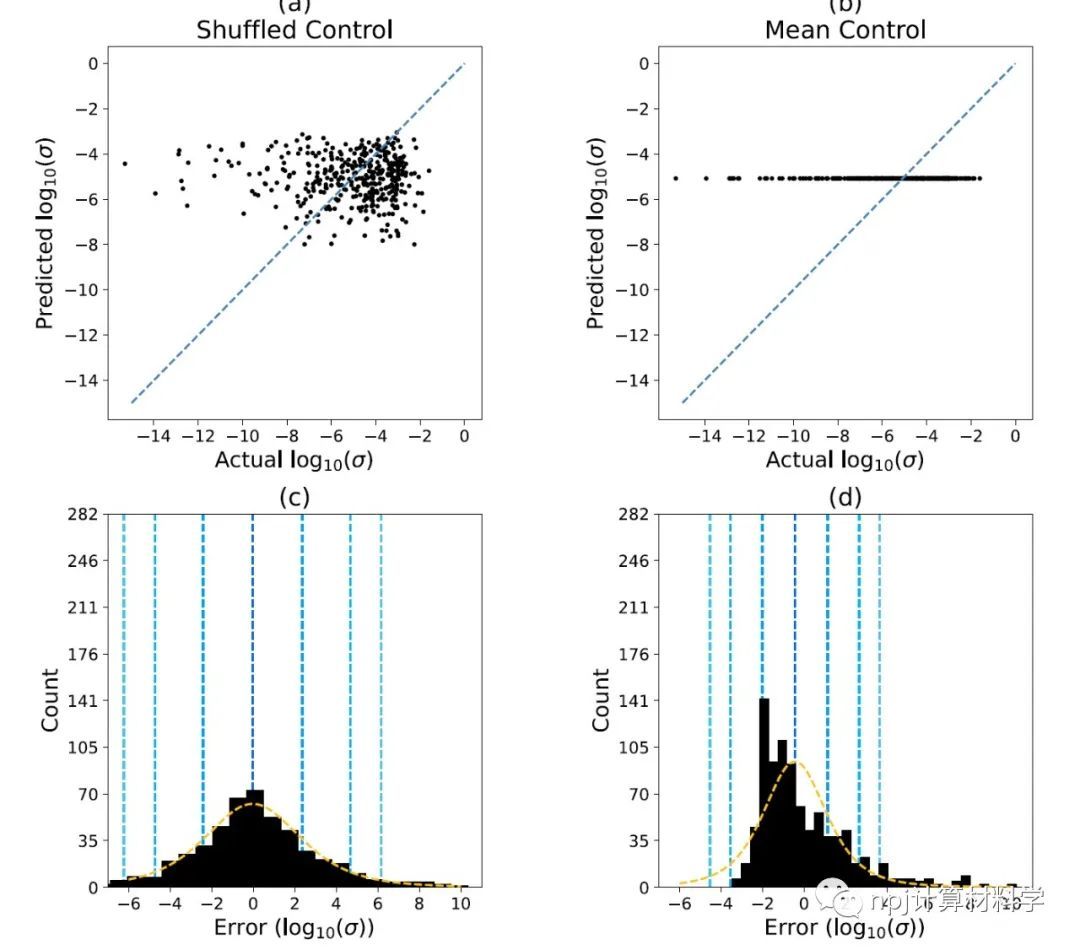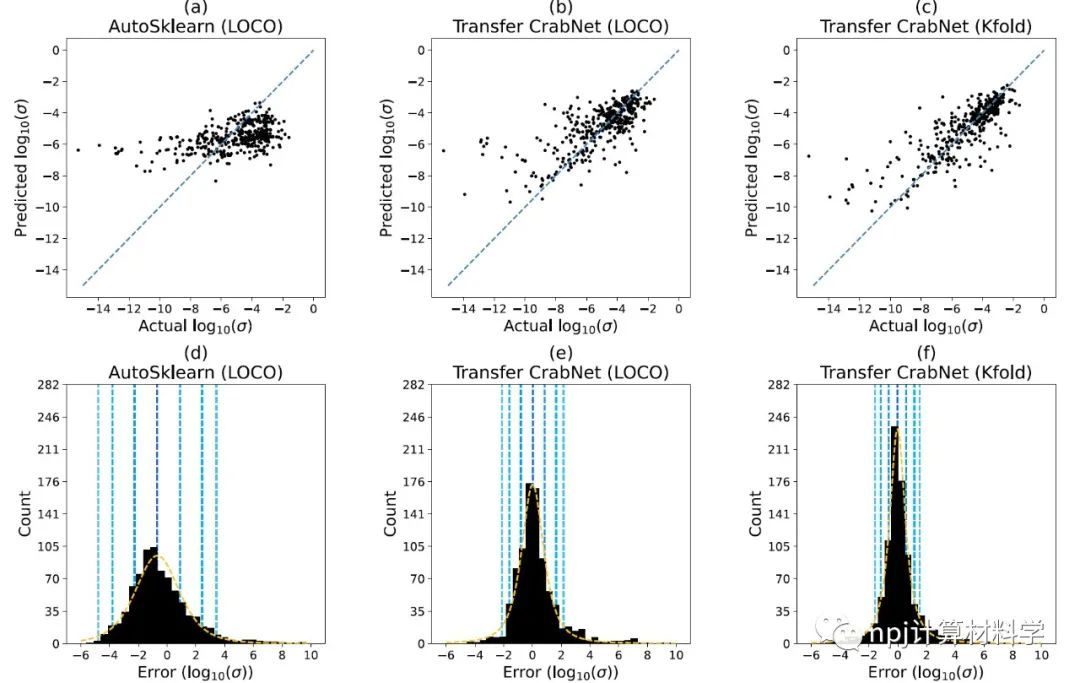能源儲存是通過利用可再生能源來滿足日益增長的能源需求的關鍵技術。液態電解質基锂離子電池已被廣泛應用于便攜式電子和電動汽車市場,而使用固態電解質的替代電池可以避免與有機液態基電解質相關的安全問題,並通過使用锂金屬陽極來提供高能量密度。

Fig. 1 Distribution in room temperature conductivities for materials in the dataset.
然而,采用固態電解質的最大障礙是尋找具備特殊性能的固態材料,包括足夠高離子電導率、對锂金屬和氧化陰極材料穩定性以及適配的機械性能。目前已有大量的研究致力于發現和開發滿足這些要求的固態電解質。最近,人們也開始使用已有的數據去訓練機器學習模型,通過材料的成分來預測材料的離子導電性能。

但這種方法受到了可用于訓練模型數據質量和數量的限制。雖然自然語言處理任務可以訪問數十億個訓練示例,但在實驗材料科學中,即使是大型數據集也通常包含不到10,000個條目。由于這些訓練集相對較小,必須使用最高質量的數據來避免向預測模型提供不准確的數據,但目前還沒有大型的實驗離子電導率數據庫供人們進行機器學習研究。

來自英國利物浦大學化學系的Cameron J. Hargreaves等人,構建了一個用于機器學習模型的锂固態電解質數據集,實現了基于成分的锂離子電導率預測。該數據集有從214個來源收集的820個條目;條目包含化學成分、專家指定的結構標簽和特定溫度下的離子電導率,其中403個化學成分具有接近室溫的離子電導率。

Fig. 4 Embeddings of the 403 unique room temperature solid state electrolytes compositional data.
作者利用無監督嵌入和聚類技術,根據成分相似度將數據集劃分爲9個族,從而評估了數據集的多樣性。監督統計(AutoSklearn)和深度學習(CrabNet)模型被應用于該數據集,實現了僅從元素成分來預測材料的離子電導率。

Fig. 5 Parity plots and error distribution for two control studies.
在不同的交叉驗證機制下,作者用標准的統計指標對回歸和分類模型進行了評估,特別是模型在預測新材料離子電導率方面的性能。他們發現,具有遷移學習的Crabnet在不同交叉驗證下都表現出了最好的性能。這種分類器是一個實用的工具,可幫助實驗人員確定優先考慮的候選锂離子導體以進行未來研究。該文近期發布于npj Computational Materials 9: 9 (2023).

Fig. 6 Parity plots and error distributions for three regression models.
Editorial Summary
Lithium solid electrolyte conductivities: A database for machine learning
Energy storage is a key technology to meet growing energy demand by harnessing renewable sources. Liquid electrolyte-based lithium ion batteries have been extensively deployed in the portable electronic and electric vehicle markets. Alternative batteries that utilize solid state electrolytes (SSEs) avoid the safety issues associated with organic liquid electrolytes and offer high energy density by enabling the use of a lithium metal anode. The most significant obstacle to the adoption of SSEs is the realization of solid-state materials with the full suite of required properties, including sufficiently high ionic conductivity, stability against both lithium metal and the oxidizing cathode material together with appropriate mechanical properties. As such, considerable research has been devoted to the discovery and development of SSEs that meet these requirements. Recent works have used previously published data to train machine learning models and predict the ionic conductivity performance of materials using only their composition. However, this approach is limited by the quality and quantity of the data available to train models. While natural language processing tasks have access to billions of training examples, in experimental materials science even large datasets typically contain fewer than 10,000 entries. Due to these comparatively small training sets, it is imperative that the highest quality data are used to avoid providing inaccurate data to predictive models. But there are no large repositories of experimental ionic conductivities currently available for solid lithium ion conductors to perform a machine learning investigation.
Cameron J. Hargreaves et al. from the Department of Chemistry, University of Liverpool, built a dataset of lithium SSEs for machine learning models to predict lithium ion conductivity based on composition. This dataset has 820 entries collected from 214 sources; entries contain a chemical composition, an expert-assigned structural label, and ionic conductivity at a specific temperature, with 403 unique compositions with an associated ionic conductivity near room temperature. Unsupervised embedding and clustering techniques were used to partition this dataset into nine families by compositional similarity, thus assessing the diversity of the dataset. Supervised statistical (AutoSklearn) and deep learning (CrabNet) models were applied to this dataset to predict the ionic conductivity of a material from its elemental composition alone. Regression andification models were evaluated with standard statistical metrics under different cross-validation regimes to assess their performance at predicting the ionic conductivities of novel materials. The results showed that CrabNets with transfer learning demonstrate the best performance under both k-folds and LOCO cross-validation. Thisifier is a practical tool to aid experimentalists in prioritizing candidates for further investigation as lithium ion conductors. This article was recently published in npj Computational Materials9: 9 (2023).
原文Abstract及其翻譯
A database of experimentally measured lithium solid electrolyte conductivities evaluated with machine learning (用機器學習評估實驗測量的锂固體電解質電導率的數據庫) Cameron J. Hargreaves, Michael W. Gaultois, Luke M. Daniels, Emma J. Watts, Vitaliy A. Kurlin, Michael Moran, Yun Dang, Rhun Morris, Alexandra Morscher, Kate Thompson, Matthew A. Wright, Beluvalli-Eshwarappa Prasad, Frédéric Blanc, Chris M. Collins, Catriona A. Crawford, Benjamin B. Duff, Jae Evans, Jacinthe Gamon, Guopeng Han, Bernhard T. Leube, Hongjun Niu, Arnaud J. Perez, Aris Robinson, Oliver Rogan, Paul M. Sharp, Elvis Shoko, Manel Sonni, William J. Thomas, Andrij Vasylenko,Lu Wang, Matthew J. Rosseinsky & Matthew S. Dyer.
AbstractThe application of machine learning models to predict material properties is determined by the availability of high-quality data. We present an expert-curated dataset of lithium ion conductors and associated lithium ion conductivities measured by a.c. impedance spectroscopy. This dataset has 820 entries collected from 214 sources; entries contain a chemical composition, an expert-assigned structural label, and ionic conductivity at a specific temperature (from 5 to 873 °C). There are 403 unique chemical compositions with an associated ionic conductivity near room temperature (15–35 °C). The materials contained in this dataset are placed in the context of compounds reported in the Inorganic Crystal Structure Database with unsupervised machine learning and the Element Movers Distance. This dataset is used to train a CrabNet-basedifier to estimate whether a chemical composition has high or low ionic conductivity. Thisifier is a practical tool to aid experimentalists in prioritizing candidates for further investigation as lithium ion conductors.
摘要機器學習模型在預測材料性能方面的應用取決于高質量數據的可用性。我們提出了一個專家策劃的數據集,包含锂離子導體及與其相關的由交流阻抗譜測量獲得的锂離子電導率。該數據集有來自214個來源的820個條目;條目包含化學成分、專家指定的結構標簽,以及特定溫度(從5到873°C)下的離子電導率。在室溫(15-35°C)附近,有403種獨特的化學成分具有相關的離子電導率。數據集中包含的材料在無機晶體結構數據庫報告的化合物中,具有無監督機器學習和元素移動距離。該數據集用于訓練基于CrabNet的分類器,以估計化學成分是否具有高或低的離子電導率。這種分類器是一個實用的工具,可以幫助實驗人員確定優先考慮的候選锂離子導體以進行未來研究。
